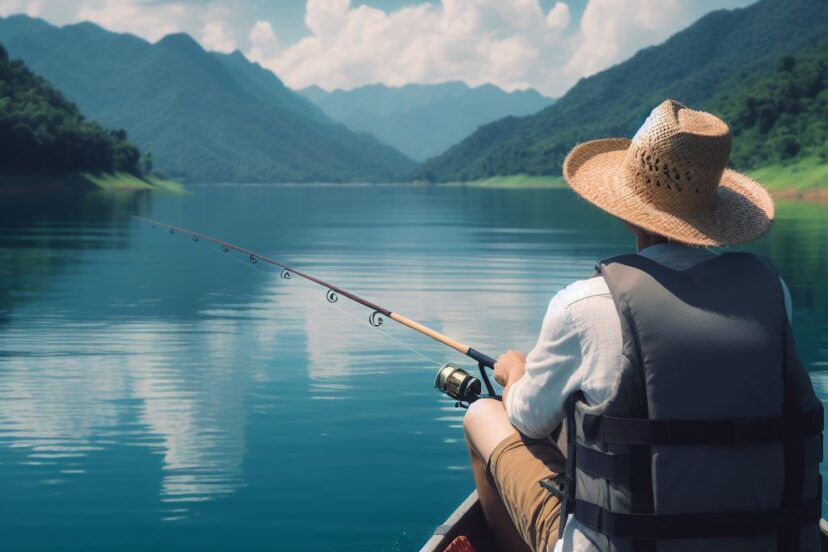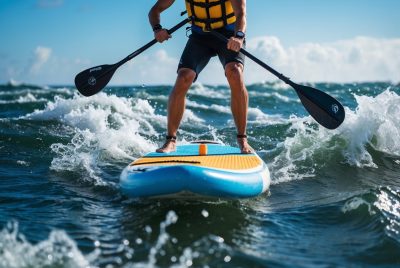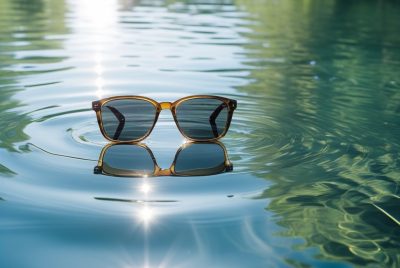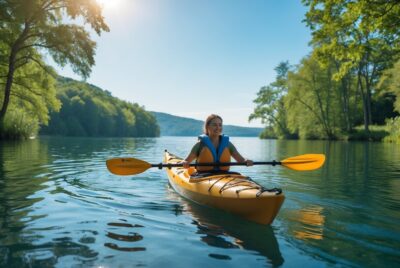Fishing On a Canoe: Angling Adventures
*We may earn a commission for purchases made using our links. Please see our disclosure to learn more.
Fishing on a Canoe: Essential Tips for a Successful Trip
Fishing on a canoe offers a unique blend of tranquility and excitement. Whether you’re paddling through serene lakes or navigating gently flowing rivers, a canoe provides access to fishing spots that are often unreachable by larger boats. Canoes designed for fishing, typically shorter and wider, offer a stable platform, making it easier to cast and reel in those big catches.

Safety is paramount when fishing on a canoe. Always wearing a properly fitting personal flotation device (PFD) is crucial, and maintaining your balance by staying centered prevents tipping. A foldable anchor can enhance stability, keeping you steady in windy conditions or strong currents.
Fishing from a canoe isn’t just about practicality; it’s about the experience. Being closer to the water and nature adds a peaceful, immersive quality to your fishing trips. Plus, the flexibility to pack camping gear or take a family along makes it a versatile choice for both solo and group adventures. Enjoy the freedom and adventure that fishing from a canoe has to offer.
Choosing the Right Canoe for Fishing

Selecting a canoe for fishing involves considering the type and material, size, stability, and maneuverability. Each factor plays a crucial role in ensuring a beneficial and enjoyable fishing experience.
Canoe Types and Materials
When it comes to material, there are multiple options suited for different needs. Aluminum canoes are durable and lightweight, making them excellent for beginners. They are resistant to impacts and easy to maintain, but can be noisy on the water.
Fiberglass canoes offer a smooth ride and are relatively easy to repair. They tend to be heavier than aluminum but provide a better glide on water.
Plastic canoes are tough and affordable, suitable for those on a budget. They require minimal maintenance but can be heavy and less efficient to paddle.
Kevlar canoes are the lightest and most efficient to paddle. They are ideal for long trips but come with a higher price tag.
Canoe Length and Width Considerations
The length of a canoe affects its speed and storage capacity. Longer canoes, around 16-17 feet, are faster and can carry more gear, making them suitable for extended trips.
Shorter canoes, about 14-15 feet, are easier to maneuver and transport. These are good for solo fishing or quick trips.
Width impacts stability and speed. Wider canoes provide more stability, which is essential for fishing but can be slower. A canoe that is approximately 36 inches wide offers a good balance between stability and performance.
Stability and Maneuverability
Stability is critical to prevent tipping, especially when fishing. Flat-bottomed canoes are very stable and ideal for calm waters. They are less suitable for rough conditions because they can be harder to control in strong winds or currents.
Rounded or shallow-arched hulls offer better secondary stability, meaning they are less likely to tip when leaning. They handle waves better and are more suitable for varied conditions.
For maneuverability, look for canoes with a rocker, or the curve from bow to stern. More rocker makes a canoe easier to turn, which is beneficial in rivers. Less rocker provides better tracking on flat water, which is advantageous on lakes.
Essential Gear for Canoe Fishing

Canoe fishing requires specific gear to ensure a safe and successful trip on the water. We’ll cover the crucial items such as personal floatation devices, fishing rods and reels, tackle storage, and anchoring systems.
Personal Floatation Devices
Safety is the top priority when fishing on a canoe. Personal Floatation Devices (PFDs) are essential. They keep you afloat if you fall overboard. There are different types of PFDs, but I recommend one designed specifically for fishing. These often have multiple pockets and attachment points for gear.
Choose a PFD that fits well and is comfortable to wear for long periods. A poorly fitted PFD can be as dangerous as not wearing one at all. Look for PFDs approved by safety standards, such as those from the U.S. Coast Guard.
Fishing Rods and Reels
The right fishing rod and reel make a significant difference in canoe fishing. When selecting a rod, consider the water you’re fishing in. For calm lakes, a light to medium spinning rod works well. For rivers, a sturdier, medium-heavy rod might be necessary. Telescopic rods are also a great space-saving option.
Reels should match the rod. Spinning reels are versatile and user-friendly, making them a good choice for most anglers. Ensure your reel can handle the type of fish you’re targeting, whether it’s bass, trout, or catfish.
Tackle and Bait Storage
Storing your tackle and bait in a canoe requires careful planning. Use a watertight tackle box to keep your gear dry. Plano StowAway boxes are popular due to their durability and compartmentalized design.
For bait, small, lidded containers help keep things organized and prevent spills. Consider using soft-sided tackle bags with detachable trays for flexibility. They fit well in canoes and can be easily moved around as needed.
Anchoring Systems
An anchoring system is vital for keeping your canoe stable while fishing. A good anchor prevents the canoe from drifting. Folding grapnel anchors are compact and effective. Ensure the anchor is heavy enough to hold your canoe in place, especially in current or windy conditions.
The anchor rope should be strong and long enough to reach the bottom securely. Some anglers prefer to use a drift sock to slow drift without stopping completely. This is helpful in maintaining a steady fishing position.
Equipped with these essential items, you’re ready for a safe and enjoyable canoe fishing experience.
Canoe Fishing Techniques

Fishing from a canoe can be a rewarding experience if you master a few key techniques. Proper casting, trolling, and sight fishing can make your time on the water both productive and enjoyable.
Casting Techniques
When casting from a canoe, it’s important to stay balanced. I always position myself in the center of the canoe to avoid tipping.
Using shorter, more controlled casts will help maintain stability. I prefer casting towards the edges of weeds or submerged structures where fish are likely to hide.
A side-arm cast can be particularly effective when seated, reducing the risk of snagging your line on the canoe or nearby objects. Pay attention to wind direction to adjust your casting angle accordingly.
Trolling from a Canoe
Trolling from a canoe allows you to cover more water and find active fish. I usually position a trolling motor at the stern for better control.
Moving quietly is key; sudden movements or noises can scare fish away. I use a trolling speed that’s just fast enough to create a lifelike lure movement without being too fast.
Setting up multiple rods with different lures can increase your chances of success. Monitor the rod tips closely for bites, and be ready to reel in quickly.
Sight Fishing Tips
Sight fishing from a canoe involves spotting fish before casting to them. This technique is especially useful in clear, shallow waters.
I like to bring polarized sunglasses to reduce glare on the water surface. This makes it easier to see fish and underwater structures.
Moving slowly and quietly is crucial; sudden movements or noises can spook fish. When you spot a fish, position the canoe at a slight angle for a better casting position. This way, I can make accurate casts towards the target without causing disturbances.
Safety Precautions and Considerations when Fishing on a Canoe

Fishing on a canoe can be a thrilling experience, but it’s important to follow key safety precautions. I’ll cover tips on weather awareness, obeying water traffic rules, and emergency preparedness.
Weather Awareness
Before setting out on your canoe fishing trip, always check the weather forecast. Weather conditions can change quickly, and being caught in bad weather can be dangerous.
I always carry a weather radio to stay updated on any sudden changes. When there’s a chance of thunderstorms or high winds, it’s best to stay off the water. It’s better to postpone a trip than to risk your safety. Dressing appropriately for the weather is crucial too. Wear quick-drying and layered clothing so you can adjust to temperature changes easily.
Water Traffic Rules
Being aware of water traffic rules is crucial for a safe canoeing experience. Always stay alert and keep an eye on other boats and watercraft. Larger boats may not see you, so it’s important to signal and make your presence known. Use a whistle to alert other boaters of your position if needed.
Stick to designated canoeing areas and follow local boating regulations. Make sure to have a clear understanding of right-of-way rules. Generally, non-motorized boats like canoes should yield to larger, faster vessels. Staying close to the shore can also help avoid collisions and allow for a quick escape route if needed.
Emergency Preparedness for Fishing on a Canoe
Having the right emergency gear can make a huge difference. Always wear a properly fitted life jacket. Carry essential safety equipment like a whistle, flares, and a first aid kit. In case of an emergency, these items can be crucial for your safety.
I always let someone know my planned route and expected return time. This way, if something goes wrong, help can be on the way more quickly. Practicing self-rescue techniques can also prepare you for unexpected situations. Knowing how to get back into your canoe if it capsizes can be a lifesaver.
Planning and preparing adequately can transform your canoe fishing trip into a safe and enjoyable adventure.
Conservation and Environmental Impact

Fishing on a canoe can be a peaceful activity, but it’s essential to engage in practices that conserve fish populations and minimize ecosystem disruptions.
Catch and Release Best Practices
When done correctly, catch and release helps maintain fish populations. I’ve learned the importance of using barbless hooks, as they make it easier to release fish without causing serious injuries. Handling the fish carefully is also crucial. Wetting my hands before touching the fish reduces damage to its protective mucus layer.
I always use a landing net with rubber coating. This type of net is less harmful to fish compared to other materials. Minimizing the time the fish is out of the water is important as well. Ideally, I try to keep it under 30 seconds. Avoiding areas with high fish concentrations ensures that too many aren’t disturbed at once.
Minimizing Ecosystem Disruption
Canoe fishing is less intrusive than motorized boats, but there are still steps necessary to protect ecosystems. I ensure that all my gear is clean to prevent the spread of invasive species. Before entering a new body of water, I inspect my canoe, paddles, and footwear.
Sticking to designated fishing areas and paths helps limit the impact on vegetation and habitats. I also make it a point to avoid dragging the canoe onshore, preventing damage to aquatic plants. Reducing noise by paddling quietly and speaking softly can help avoid disturbing wildlife.
By following these steps, I contribute to preserving the natural environment while enjoying the sport. It’s a balance between enjoying nature and protecting it for future generations.
Frequently Asked Questions
Choosing the right gear, setting up safely, and managing your fishing trip with a partner can make your canoe fishing experience enjoyable and efficient. Additionally, finding great locations and understanding the benefits of using a canoe can enhance your adventure.
What are the essential gear recommendations for canoe fishing?
When fishing from a canoe, I recommend a lightweight and compact tackle box. Bring multiple rods, including a shorter one for casting in tight spaces. Always include a waterproof storage bag for your phone and other electronics. Use a paddle leash and don’t forget a comfortable, high-back seat cushion.
How do I safely set up my fishing gear in a canoe?
Safety is crucial. Ensure your gear is balanced to avoid tipping. I place heavier items in the center and keep frequently used items within easy reach. Always secure your rods and tackle to prevent loss if the canoe tips. Wearing a life jacket at all times is essential.
What are some tips for beginners starting to fish from a canoe?
For beginners, I suggest practicing paddling and casting before going fishing. Start with calm waters to build your confidence. Use stable and durable canoes. Keep your movements slow to maintain balance. Carry a small first-aid kit and know basic water safety.
How can two people effectively manage fishing on a canoe?
Teamwork is key. Clear communication about paddling, casting, and netting fish helps avoid accidents. I recommend sitting opposite each other for better balance. One person can handle steering while the other focuses on fishing. Sharing responsibilities for gear setup makes the process smoother.
What are the advantages of using a canoe for fly fishing?
Canoes offer stealth and access to remote spots that are hard to reach from the shore. I find the higher vantage point better for spotting fish. The ability to stand up in some canoes provides improved casting angles. Canoes are quiet, minimizing disturbances and increasing your chances of success.
Where can I find locations suitable for canoe fishing?
Many local wildlife departments list fishing spots on their websites. I often check these resources for recommendations. State parks and national forests usually have suitable waters. Joining local fishing clubs can also provide insights and access to private locations.




